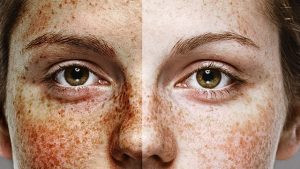Australians love the outdoor life and the sun but too much sun exposure can significantly damage human skin.
The most common types of sun damage to the skin are:
- Dryness – sun exposed skin can gradually lose moisture and essential oils, making it appear dry, flaky and prematurely wrinkled, even in younger people
- Sunburn – a common name for the skin injury that appears immediately after the skin is exposed to UV radiation. The symptoms vary from painful reddening to blisters. The long term effects of multiple sunburns are skin cancers which start to develop years later.
- Actinic keratosis – small bumps that feel like sandpaper or a scaly patch which has pink, yellow, red or brownish tint. They can grow bigger over time and progress to squamous cell carcinoma. They don’t go away unless treated.
- Long-term changes in the skin’s collagen – this includes photoaging (premature aging of the skin because of sun exposure) and actinic purpura (bleeding from the fragile vessels beneath the skin surface). The skin develops wrinkles and fine lines and loses elasticity because of the changes in the collagen of the deep layer of the skin called dermis. It develops excessive pigmentation due to increased production of melanin and redness due to structural damage of the tiny blood vessels (capillaries).
Prevention of sun damage cannot be underestimated. It includes limiting sun exposure, covering up (protective clothing, hats, sunglasses and using sunscreens).
Regular skin checks are highly recommended.
Although it is not possible to reverse all of the effects of long-term sun damage there are a number of treatments available to remove actinic keratosis and improve the solar damage and the appearance of the skin. These include:
- Cryotherapy to actinic keratosis (freezing the spots with liquid nitrogen)
- Topical treatments with Picato gel or Efudix and Aldara creams (targeting precancerous lesions or early skin cancers)
- Photodynamic Therapy which combines the use of Efudix cream for few days to bring up the sun damaged areas and application of ALA cream for a 1.5 hours which is followed by treatment with Intense Pulsed Light. This treatment targets precancerous changes, dryness, sun pigmentation (solar lentigos) and excessive redness.
- Laser resurfacing with CO2 or Fraxel lasers to improve skin quality and pigmentation
- Laser treatment targeting pigmentation, excessive blood vessels, broken capillaries or diffuse redness.
Include Kamilla Video here https://youtu.be/yMQHtKcaPtQ
If you would like more information on our treatments or to book a complimentary consultation, please call our friendly team on (08) 9368 6888.
Dr. Kamilla






